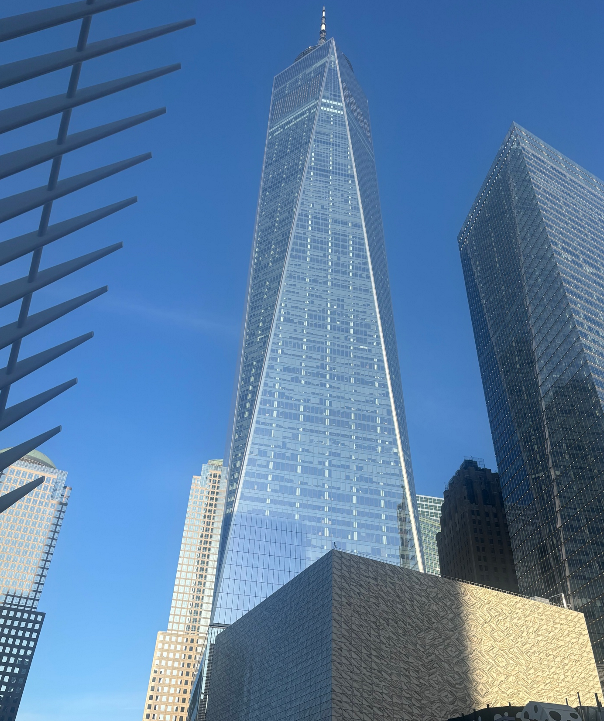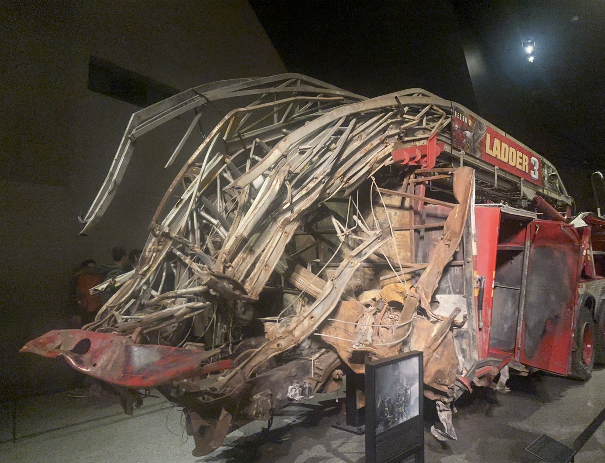
By Paddy McCarthy
Myself and my family were Out&About last Sunday to visit the National September 11 Memorial & Museum for the very first time. The memorial and museum are part of the World Trade Center complex, in New York City, created to remember the September 11, 2001, attacks, which killed 2,977 people, and the 1993 World Trade Center bombing, which killed six.
To see this first hand is I might tell you a very sad occasion, to see what had happened on that day, September11th created one of the worst disasters to happen in America. I am now mourning.
Composed of 2,983 individual paper panels, Finch’s installation is a panoramic mosaic of color that attests to the magnitude of the disaster and its incalculable cost in human lives. Reflecting on the information that I got from the 9/11 Memorial and Museum brought back all the memories of the saddest day to happen in the City of New York and forget about all the politics and think about something in my mind that is more important in our lives.
I am now going to be connecting you with the past on this special Out&About as I am sure it gives good information and emphasize that you have got to go and see it for yourself if you haven’t already.

The Museum’s ramped descent offers views into the vast cavity of the original World Trade Center complex. After 9/11, preservationists, survivors, and other advocates fought to ensure that the World Trade Center site and its archaeological remnants were saved. Typically, properties are not considered for the National Register of Historic Places until 50 years after they achieve historical significance.
The World Trade Center site, however, became eligible in February 2004 after it was deemed to be “exceptionally significant in the history of the United States as the location of events that immediately and profoundly influenced the lives of millions of American citizens.”

One of these historic remnants, known as the Survivors’ Stairs, lies at the end of the ramp. On 9/11, this staircase at the edge of the elevated World Trade Center Plaza provided an unobstructed exit for people fleeing the site. After 9/11, the stairs were slated for demolition but were saved during the federal review process of the site’s historic assets. As visitors arrive at the main exhibition and education level, they follow the stairs that led hundreds of survivors to safety on September 11, 2001.
Visitors descend to the main exhibition and education level via a ramp that evokes a history of construction ramps at the World Trade Center site: one to build the original complex in the 1960s and another installed during the post-9/11 recovery period to remove wreckage from the site and grant victims’ family members access to Ground Zero.
At bedrock, visitors encounter two monumental spaces: Memorial Hall and Foundation Hall. In Memorial Hall, located between the footprints of the original Twin Towers, two site-specific artworks are on view. A quotation forged from recovered World Trade Center steel by artist and blacksmith Tom Joyce—“No day shall erase you from the memory of time”—speaks to the Museum’s promise to remember the 2,983 lives lost on 9/11 and in the 1993 World Trade Center bombing. Surrounding the letters of the Virgil quote is a work by artist Spencer Finch titled Trying to Remember the Color of the Sky on That September.
The largest space in the Museum is Foundation Hall, situated beside the North Tower footprint. The backdrop for Foundation Hall is a monumental portion of the slurry wall, a concrete retaining wall built to hold back the waters of the nearby Hudson River when the World Trade Center site was first excavated in the mid-1960s. Following the collapse of the towers on 9/11, the slurry wall remained intact—a potent symbol of strength and resilience.

At the center of Foundation Hall stands the Last Column, the final piece of World Trade Center steel to be removed from Ground Zero. As rescue and recovery workers cleared the site after 9/11, they covered the 36-foot steel column from top to bottom with inscriptions, mementos, and signatures. The Last Column was removed from the World Trade Center site on May 30, 2002, in a ceremony marking the official end of the recovery period.
Exhibition spaces, conceived by lead designers Thinc Design in collaboration with Local Projects, provide visitors with an indelible encounter with the story of the attacks situated within the authentic site of the World Trade Center. The Museum’s core exhibitions are located inside the footprints of the North and South Towers. In Memoriam, the Museum’s memorial exhibition in the South Tower footprint, commemorates the victims of the attacks of September 11, 2001 and February 26, 1993.
In the North Tower footprint, the Museum’s historical exhibition designed by Layman Design, September 11, 2001, revisits the events of that day and explores the attacks’ historical antecedents as well as their aftermath and lasting repercussions. Layman Design was brought on board in 2010 to advance and finalize design development of the historical exhibition.
The Museum also has two galleries for rotating, temporary exhibitions. The South Tower Gallery in the South Tower footprint is dedicated to exhibitions of photography and artwork. The Special Exhibitions Gallery, in the North Tower footprint, explores topics of contemporary significance that speak to the ongoing ramifications of 9/11. This gallery is temporarily closed.
This is the message from Michael Bloomberg to which says: “Dear Subscriber, As Chairman of the 9/11 Memorial & Museum, I want to personally welcome you to our online community. Together, we can ensure this sacred site of remembrance, reflection, and learning endures for future generations. The attacks of February 26, 1993 and September 11, 2001 changed our world forever.
“We will always remember the 2,983 men, women, and children killed, as well as those who risked their lives to save others and all who demonstrated extraordinary compassion in the aftermath of the attacks.
“Today, it is more important than ever to help a new generation understand the lessons of 9/11 and how we faced adversity with resilience and hope As a nonprofit organization that receives only limited government funding, we rely overwhelmingly on the generosity of our visitors and donors to deliver world-class education programs and exhibitions, and to ensure the 9/11 Memorial remains free for all who wish to visit.
“Whether you are planning a visit or want to deepen your connection to our mission of commemoration, education, and inspiration, I hope you will consider becoming a Museum Member at whichever level is right for you. Thank you for joining me in honoring and remembering. I look forward to staying connected.”.
I have included some of the photos that I took inside of the Museum to just give some idea what had happened and if you ever visit the New York City please go and visit the Museum.
I am now going to continue some more history on another great man, Gerry Adams, who has a documentary film coming to the theatres that should not be missed that needs your support. It came to me from a great friend of The Irish Examiner USA and of mine as he is well known in the Irish community, Marty Glennon, I had to get that in am I right?.
It is very interesting and I have included it in my Out&About because I want to personally bring it to your attention so here goes: “As many of you may not be aware, in 2001 after the attacks on September 11th, Gerry Adams, at the Sinn Féin fundraiser in NYC, decided that all the money that was raised should go to a relief fund for all the construction workers who lost their lives on 9/11.
“While much attention was paid to the first responders and those lost from Wall street, Gerry wanted to help those in the Labor movement.
“Over the years, Gerry has been gracious in coming to NYC for the Annual Irish Labor Awards and hosted Labor delegations that came to Ireland.
“Gerry Adams has been a true friend to the Labor movement in NYC and worldwide. He has spoken at the James Connolly Irish American Labor Coalition dinners on more than one occasion. He worked with the US Labor Unions to have the James Connolly Center built on the Falls Road in Belfast.
“I’m writing to you now to alert you to an opportunity to show your appreciation for the life’s work of Gerry Adams by being a supporter of a feature documentary of Gerry Adams – A Ballymurphy Man. You can watch the trailer here: https://212berlin.com/wp-content/uploads/2024/09/gerry_adams__a_ballymurphy_man-1440p.mp4.
“This documentary was created and directed by renowned filmmaker Trisha Ziff. The project is a tax deductible 501(c)(3). For the film to be distributed, Trisha needs to raise $50,000. Please consider contributing to a project that highlights the work of civil rights activist, Gerry Adams.
“Your union or organization can be listed in the credits of the film as an Associate Producer for a contribution of $5,000 and for $9,000 you will not only be listed as a Producer but will also receive a Private Screening. There are also other credits and gifts for lesser contributions.”
Contact Marty for more information on donating. This is something that is well worth supporting and I am 100% behind it!
I hope to see you all again next week when I am Out&About again…
